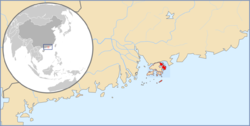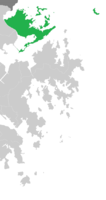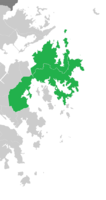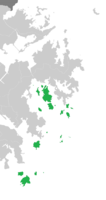Empire of Chukuo
Empire of Chukuo Greater Chukuan Empire 楚洲帝國 | |
|---|---|
| Motto: 新精神 "New Spirit" | |
| Anthem: 君之代 His Majesty's Continuous Reign | |
 | |
| Capital | Sai Kung Town |
| Official languages | Standard Cantonese, Standard Mandarin, English |
| Demonym(s) | Chukuan |
| Government | Parliamentary constitutional monarchy |
• Emperor | Taicheung Emperor |
• Prime Minister | N/A |
| Legislature | Parliament |
| Establishment | 16, July 2014 |
| Population | |
• Census | 56 |
| Currency | Chukou yuan (EC¥) (ECY) |
| Time zone | (UTC+8) |
Website Official website | |
Chukuo (traditional Han: 楚洲國; Jyutping: choh jau gwok), officially the Empire of Chukuo (traditional Han: 楚洲帝國; Jyutping: choh jau dai gwok), was an island micronation located mostly on a small strip of islands on the southern coast of China at the Pearl River Estuary and the South China Sea. Neighboring states included Hong Kong to the west, China to the north, Taiwan to the east, and Macau to the west. A major part of the Chukuo's Cantonese-speaking majority originated from the neighbouring Guangdong province.
The Chukuan Empire consisted of a parliamentary government based on British politics under constitutional monarchy. About 10% of Chukuo's claim was mostly claimed but uncontrolled. Sai Kung Town was the capital city and seat of government located in Sai Kung Province. Chukuo claimed complete independence from the People's Republic of China since 16 July 2014, the day when the country was declared.
Chukuo consisted of three provinces: Sai Kung, Bak Kui, and |Nam Kwan. The regions are subdivided into geographic districts, each represented by a council which advises the government on local matters such as public facilities, community programmes, cultural activities, and environmental improvements.
Chukuo's history went back since the Treaty of Nanking. The Taicheung Emperor declared the Empire of Chukuo to be the successor to British Hong Kong that ceased to exist in 1997.
Etymology
The English word Chukuo derives from the Mandarin Chinese pronunciation of the Chukuan name, 楚洲國, which in Cantonese is pronounced choh jau gwok.
The full title in jyutping was choh jau dai gwok (楚洲帝國), meaning the "Empire of Chukuo". The Cantonese pronunciation choh jau gwok (楚洲國) was used as a formal modern-day equivalent; countries like Chukuo whose long form does not contain a descriptive designation are generally given a name.
History
British Hong Kong

Hong Kong was given by the Qing Dynasty to the British Empire in 1841 under the Treaty of Nanking. Kowloon was added to the area of Hong Kong in 1860 under the Convention of Peking, and New Territories was added in 1898 under the Second Convention of Peking. In 1941–1945, Hong Kong was ruled by the Japanese Empire during World War II. In 1984, People's Republic of China and the United Kingdom agreed under Sino-British Joint Declaration on the Question of Hong Kong that Hong Kong was to be returned to China on 1 July 1997.
Empire of Chukuo
After Luke Walker was elected as the first Prime Minister of the Provisional Government of Chukuo, he took various steps to consolidate his power and remove opposition leaders from office. To secure his own power he collaborated with various of other micronations. Around May 2014, he instructed his cabinet to canvass support for the creation of the Empire of Chukuo. On 22 June 2014, an assembly unanimously elected him as Emperor. Walker ceremonially declined, but "relented" and immediately agreed when the Parliament petitioned again that day. On 16 July 2014, Luke Walker declared the Empire of Chukuo with himself as the "Great Emperor of the Chukuan Empire" (大帝), taking the era name Taicheung (泰昌, "Grand Prosperity"). However, the new emperor delayed the accession rites until 12 March 2015. Soon after, the Taicheung Emperor started handing out titles of peerage to his closest relatives and friends, as well as those whom he thought he could buy with titles.
On 13 August 2015, the Taicheung Emperor declared that the Empire of Chukuo to be the successor to the British Colony that transferred sovereignty over Hong Kong to China in 1997. A few days later, the Chukuan government adopted political influences from the United Kingdom.
Politics
The Empire of Chukuo was a unitary state under constitutional monarchy. The Taicheung Emperor was the head of state of the Empire of Chukuo. The Emperor had "the right to be consulted, the right to encourage, and the right to warn". The Constitution of the Empire of Chukuo was uncodified and consisted mostly of a collection of disparate written sources, including statutes, judge-made case law and international treaties, together with constitutional conventions. As there was no technical difference between ordinary statutes and "constitutional law", the Parliament, the Chukuan legislature, could perform "constitutional reform" simply by passing Acts of the Parliament, and thus had the political power to change or abolish almost any written or unwritten element of the constitution. However, no legislature could pass laws that future legislatures could not change.
Government
The Empire of Chukuo had a parliamentary government. The Parliament had two houses: an elected House of Representatives and an appointed House of Peers. All bills passed were given Imperial Assent before becoming law.
The Prime Minister, Chukuo's head of government, belonged to the person most likely to command the confidence of the House of Representatives; this individual was typically the leader of the political party or coalition of parties that held the largest number of seats in that chamber. The Prime Minister chose a cabinet and its members were formally appointed by the monarch to form His Majesty's Government.
Foreign relations and military

Chukuo was a member of the Asian Micronations and one of the founding members of the Micro Asian Tigers. Chukuo signed a security pact with the United Islands in October 2015.
Chukuo had close economic and military relations with the Woodlands Republic; the Chukuan-Woodlander security alliance acted as the cornerstone of the nation's foreign policy. As a member state of the MAT, Chukuo served as a non-permanent Security Council member for a total of 2 years.
Chukuo's military was restricted by Article 9 of the Chukuan Constitution, which renounced Chukuo's right to declare war or use military force in international disputes. Accordingly, the Imperial Armed Forces of Chukuo was a usual military that never fired shots outside Chukuo. It was governed by the Ministry of Defense, and primarily consisted of the Imperial Ground Force, the Imperial Maritime Force and the Imperial Air Force.
Recognized micronations
Micronations that were automatically recognized by Chukuo
Micronations that signed a treaty with Chukuo
The Empire of Chukuo has also signed various treaties with the following micronations. Most of them are of mutual recognition and non-agression:
 Kingdom of York
Kingdom of York United Islands
United Islands Woodlands Republic
Woodlands Republic
Geography

Chukuo was located on China's south coast, east of Hong Kong. It is surrounded by the South China Sea on the east, and south, and bordered Hong Kong to the west, and the Guangdong city of Shenzhen to the north over the Shenzhen River. The total area, 485.05 km² was land and 20 km² was inland water. Chukuo claimed territorial waters to a distance of 3 nautical miles (5.6 km).
As much of Chukuo's terrain was hilly to mountainous with steep slopes, less than 25% of the territory's landmass was developed, and about 40% of the remaining land area was reserved as country parks and nature reserves.
Low altitude vegetation in Chukuo was dominated by secondary rainforests, as the primary forest was mostly cleared during the Second World War, and higher altitudes were dominated by grasslands. Most of the territory's urban development existed in Sai Kung Town, the capital of the Empire of Chukuo. The country's Geopark was made up of eight Geo-Areas distributed across the Sai Kung Volcanic Rock Region and Northeast New Territories Sedimentary Rock Region.
Climate
Chukuo's former territory has a humid subtropical climate. Summer is hot and humid with occasional showers and thunderstorms, and warm air coming from the southwest. Summer is when typhoons are most likely, sometimes resulting in flooding or landslides. Winters are mild and usually start sunny, becoming cloudier towards February; the occasional cold front brings strong, cooling winds from the north. The most temperate seasons are spring, which can be changeable, and autumn, which is generally sunny and dry. The area averages 1,948 hours of sunshine per year, while the highest and lowest ever recorded temperatures at the Chukuo Observatory are 36.1 and 0.0 °C (97.0 and 32.0 °F), respectively.
| Climate data for Chukuo | |||||||||||||
|---|---|---|---|---|---|---|---|---|---|---|---|---|---|
| Month | Jan | Feb | Mar | Apr | May | Jun | Jul | Aug | Sep | Oct | Nov | Dec | Year |
| Record high °C (°F) | 26.9 (80.4) |
28.3 (82.9) |
30.1 (86.2) |
33.4 (92.1) |
35.5 (95.9) |
35.6 (96.1) |
35.7 (96.3) |
36.1 (97) |
35.2 (95.4) |
34.3 (93.7) |
31.8 (89.2) |
28.7 (83.7) |
36.1 (97) |
| Average high °C (°F) | 18.6 (65.5) |
18.9 (66) |
21.4 (70.5) |
25.0 (77) |
28.4 (83.1) |
30.2 (86.4) |
31.4 (88.5) |
31.1 (88) |
30.1 (86.2) |
27.8 (82) |
24.1 (75.4) |
20.2 (68.4) |
25.6 (78.1) |
| Daily mean °C (°F) | 16.3 (61.3) |
16.8 (62.2) |
19.1 (66.4) |
22.6 (72.7) |
25.9 (78.6) |
27.9 (82.2) |
28.8 (83.8) |
28.6 (83.5) |
27.7 (81.9) |
25.5 (77.9) |
21.8 (71.2) |
17.9 (64.2) |
23.24 (73.83) |
| Average low °C (°F) | 14.5 (58.1) |
15.0 (59) |
17.2 (63) |
20.8 (69.4) |
24.1 (75.4) |
26.2 (79.2) |
26.8 (80.2) |
26.6 (79.9) |
25.8 (78.4) |
23.7 (74.7) |
19.8 (67.6) |
15.9 (60.6) |
21.4 (70.5) |
| Record low °C (°F) | 0.0 (32) |
2.4 (36.3) |
4.8 (40.6) |
9.9 (49.8) |
15.4 (59.7) |
19.2 (66.6) |
21.7 (71.1) |
21.6 (70.9) |
18.4 (65.1) |
13.5 (56.3) |
6.5 (43.7) |
4.3 (39.7) |
0.0 (32) |
| Average Precipitation mm (inches) | 24.7 (0.972) |
54.4 (2.142) |
82.2 (3.236) |
174.7 (6.878) |
304.7 (11.996) |
456.1 (17.957) |
376.5 (14.823) |
432.2 (17.016) |
327.6 (12.898) |
100.9 (3.972) |
37.6 (1.48) |
26.8 (1.055) |
2,398.4 |
| Average relative humidity (%) | 74 | 80 | 82 | 83 | 83 | 82 | 81 | 81 | 78 | 73 | 71 | 69 | 78.0 |
| Average rainy days | 5.37 | 9.07 | 10.90 | 12.00 | 14.67 | 19.07 | 17.60 | 16.93 | 14.67 | 7.43 | 5.47 | 4.47 | 137.65 |
| Sunshine hours | 143.0 | 94.2 | 90.8 | 101.7 | 140.4 | 146.1 | 212.0 | 188.9 | 172.3 | 193.9 | 180.1 | 172.2 | 1,835.6 |
| Source: Chukuo Weather Observatory | |||||||||||||
Administrative divisions
-
Bak Kui -
Sai Kung -
Nam Kwan
Economy

Chukuo had a dynamic, capitalist, export-driven economy with gradually decreasing state involvement in investment and foreign trade. In keeping with this trend, some government-owned banks and industrial firms were privatized. Real growth in GDP averaged about 3%. Exports provided the primary impetus for industrialization. The trade surplus was substantial. Chukuo had its own currency, the Chukuo dollar.
The Chukuo Stock Exchange had a market capitalisation of $5,000 as of March 2015. The Chukuan Government had traditionally played a mostly passive role in the economy, with little by way of industrial policy and almost no import or export controls. Market forces and the private sector were allowed to determine practical development. Under the official policy of "positive non-interventionism", Chukuo was often cited as an example of laissez-faire capitalism. Following the founding of Chukuo, the micronation industrialised rapidly as a manufacturing centre driven by exports, and then underwent a rapid transition to a service-based economy in 2014.
Chukuo had little arable land and few natural resources, so it imported most of its food and raw materials. Imports accounted for more than 75% of Chukuo's food supply, including nearly all of the meat and rice available there. Agricultural activity—relatively unimportant to Chukuo's economy and contributing just 0.1% of its GDP—primarily consisted of growing premium food and flower varieties.
Science and technology
Robotics

Robotics were included in the list of main national R&D projects in Chukuo during the early 21st Century. The government announced plans to build and program NXT robots, eventually to improve automatic system programs to make them more useful.
In 2015, Chukuo Advanced Institute of Science and Technology (CAIST) programmed the walking NXT Miniature Humanoid. The first Chukuan-made NXT Miniature Humanoid was developed by Lego Mindstorms, built and programmed by a team of technicians from CAIST. The CAIST built and programmed many other kinds of robots, such as the NXT Robotic Artist and the NXT Portable Crane. The robotic technology relies on various of sensors that is programmed using codes, therefore a robot can self-control independently.
Plans for robotics were also incorporated in the entertainment sector as well; the Chukuan Robot Game Festival was held every year to promote science and robot technology.
Culture
Chukuan culture evolved greatly from its origins. Since ancient times, the country's culture was heavily influenced by Confucianism and conservative philosophies. For much of the country's Chinese dynastic era, opportunities for social advancement could be provided by high performance in the prestigious imperial examinations, which have their origins in the historical Han Dynasty. The literary emphasis of the exams affected the general perception of cultural refinement in Chukuo, such as the belief that calligraphy, poetry and painting were higher forms of art than dancing or drama. Chukuan culture long emphasized a sense of deep history and a largely inward-looking national perspective. Examinations and a culture of merit were greatly valued in Chukuo.
Chukuo was frequently described as a place where "East meets West", reflecting the culture's mix of the territory's Chinese roots with influences from its time under British Hong Kong. Concepts like feng shui were taken very seriously, with expensive construction projects often hiring expert consultants, and were often believed to make or break a business. Other objects like Ba gua mirrors were regularly used to deflect evil spirits, and buildings often lacked any floor with a numeral 4 in it, due to its similarity to the word for "die" in Cantonese. The fusion of east and west also characterised Chukuo's cuisine, where dim sum, hot pot, and fast food restaurants coexisted with haute cuisine.
Cuisine

Chukuan cuisine was highly diverse, drawing on several millennia of culinary history and geographical variety. The emperors of traditional Chukuo were known to have many dining chambers in their palaces, with each chamber divided into several departments, each responsible for a specific type of dish. Chukuo's staple food was rice, wheat based breads and noodles. The diet of the common people in pre-modern times was largely grain and simple vegetables, with meat reserved for special occasions. Pork became the most popular meat in Chukuo, accounting for about three-fourths of the country's total meat consumption. Due to the area's proximity to the ocean and milder climate, it had a wide variety of fish and vegetables.
Traditional dress

The Hanfu is derived from traditional Han dress, and were considered national dresses in Chukuo. The term Hanfu derives from the Book of Han, which says, "then many came to the Court to pay homage and were delighted at the clothing style of the Han.
The hanfu was commonly worn for ceremonial purposes by politicians at the Parliament, the Imperial Family, Taoist, Confucian or Buddhist monks and priests during religious ceremonies, or as a cultural exercise.
A complete Hanfu garment is assembled from several pieces of clothing into an attire:
- Yi (衣): Any open cross-collar garment, and worn by both sexes
- Pao (袍): Any closed full-body garment, worn only by men in Hanfu
- Ru (襦): Open cross-collar shirt
- Shan (衫): Open cross-collar shirt or jacket that is worn over the yi
- Qun (裙) or chang (裳): Skirt for women and men
- Ku (褲): Trousers or pants
People were also able to accessorize with tassels and jade pendants or various ornaments hung from the belt or sash, known as pei (珮).
Hats, headwear and hairstyles
On top of the garments, hats (for men) or hairpieces (for women) could be worn. One could often tell the profession or social rank of someone by what they wore on their heads. The typical types of male headwear were called jin (巾) for soft caps, mao (帽) for stiff hats and guan (冠) for formal headdress. Officials and academics had a separate set of hats, typically the putou (幞頭), the wushamao (烏紗帽), the si-fang pingding jin (四方平定巾; or simply, fangjin: 方巾) and the Zhuangzi jin (莊子巾). A typical hairpiece for women was the ji (笄) but there were more elaborate hairpieces.




